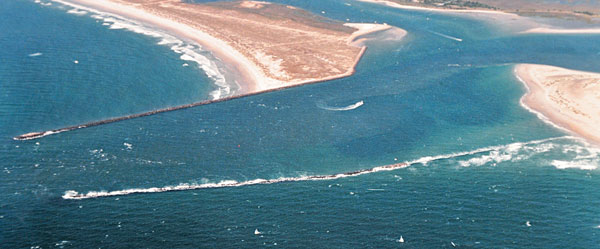
Environmentalists have had their panties in a knot for years about the prospect of “terminal groins” (jetties) being placed along North Carolina’s coastline.
They have some valid objections — mainly that over time, jetties cause some downstream erosion of the shoreline. However, most of the hysteria over jetties has been overblown. The claim that jetties would reduce the ability of saltwater fish to reproduce in inland waters is the most outlandish claim. It just ain’t so, for obvious biological reasons.
But now the state legislature, which regularly comes up with loopy ideas, finally wrote a good bill, albeit too late for several now-deceased sportsfishermen. Over the long haul, the bill should save a ton of taxpayer money, increase the safety of boaters and be a boost to coastal economies.
Senate Bill 110, which became law June 28 when Gov. Beverly Perdue failed to veto it, permits building of jetties at some inlets if certain requirements are met, including that a concurrent “beach-fill” project be part of jetty plans and “there are sufficient financial resources to cover the costs associated with the terminal groin.” The jetty also couldn’t cause damage to private property or public beaches.
These details almost certainly ensure North Carolina’s coastline won’t come to resemble New Jersey’s, where so many “groins” have been placed that all one can do when viewing that state’s beaches is groan.
Now the question becomes, which inlets actually need jetties? Why only inlets? What about dredging?
The federal government just this year stopped contributing funds to have inlets dredged, which means coastal communities are scrambling to find cash to pay the U.S. Army Corps of Engineers to work hoppers that have, in the past, kept open inlets for recreational and commercial boats. With coastal fishing worth billions of dollars to the state’s economy, having access to the ocean is crucial to keeping revenues flowing. The corps wants $450,000 for 2011 to keep Topsail Inlet open. Bogue, Carolina Beach and Lockwood Folly inlets will cost about the same. Keeping Oregon Inlet open costs an astounding $4 million annually.
It doesn’t take a rocket scientist to figure out that jetties nearly would eliminate most of those annual costs, stabilize inlets and make them safer. Hundreds of boats have swamped and lives have been lost at Oregon Inlet because shoaling created dangerous conditions.
For those who claim jetties ruin beaches, take a look at Google Earth. Recently, I viewed Masonboro and Little River inlets, where jetties have existed for years. None of the much-feared beach erosion exists on either side of the jetties. Masonboro Island, south of the jetties, looks the same as it always has; same for Little River Inlet on the South Carolina border. The “sky-is-falling” alarms sounded by enviros don’t hold a drop of water if you look at the inlets from overhead.
Masonboro, we’re told, requires dredging once every 15 years. The same is likely true for Little River. Beaufort Inlet is so wide and deep jetties aren’t needed; the same goes for the mouth of the Cape Fear River.
Jetties at a few heavily-used North Carolina inlets are a no-brainer, it appears, regardless of dire predictions.




Be the first to comment